![]() Earlier this year a study published in The New England Journal of Medicine reported, “saw palmetto did not improve symptoms or objective measures of benign prostatic hyperplasia.” The results were interesting in light of the fact that the weight of the medical literature supports the value of saw palmetto for this condition.
Earlier this year a study published in The New England Journal of Medicine reported, “saw palmetto did not improve symptoms or objective measures of benign prostatic hyperplasia.” The results were interesting in light of the fact that the weight of the medical literature supports the value of saw palmetto for this condition.
Monthly Archives: July 2006
CAM use among women with breast cancer
The use of CAM is widespread in this group of patients. The Oregon Health Sciences University in Portland reports between 66% and 84% ? the majority of whom use CAM without a recommendation from their doctor.
The most common reasons for the use of CAM among women with breast cancer is to reduce the symptoms of psychological distress. Whereas, the lowest frequency of CAM use is associated with dissatisfaction with traditional medical care.
Relaxation/meditation, herbs, spiritual healing, nutritional supplements, and megavitamins were also mentioned by the patients in these surveys.
Based on an earlier post, perhaps CAM should be considered in the early post operative phase or even presurgery.
7/30/06 16:09 JR
CAMophobia at NEJM
The New England Journal of Medicine published an article in 1999 that made an erroneous association between poorer psychological outcomes in women post breast cancer surgery and their use of CAM.
Here’s the summary quote (my italics). Note the emphasis in the NEJM study on assessment before surgery, while others focus on post surgical assessment results.
“Mental health scores were similar at base line among women who decided to use alternative medicine and those who did not, but three months after surgery the use of alternative medicine was independently associated with depression, fear of recurrence of cancer, lower scores for mental health and sexual satisfaction, and more physical symptoms as well as symptoms of greater intensity.”
The problem with the study was that these 480 patients with newly diagnosed early-stage breast cancer were recruited from a Massachusetts statewide cohort of women participating in a study of how women choose treatment for cancer.
Even back then it was recognized that the response to surgery varies among women. Some experience a strong sense of loss and need time to grieve. Others need time to adjust to an altered body image. Many patients feel a sense of relief following surgery, but worries about the long-term prognosis and follow-up therapy can cause added anxiety.
More recently, investigators found that the process of “denial coping” following surgery is a powerful predictor of future health fears. They concluded that there is a need to identify the interventions that can decrease this denial, and whether this then decreases health fears in the aftermath of breast cancer surgery.
7/30/06 16:44 JR
Unintended consequences: treating iron deficiency leads to feminism
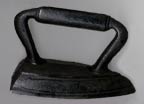 Here, from California Medicine Man via Instapundit, is one of the most important advances in medicine. Continue reading Unintended consequences: treating iron deficiency leads to feminism
Here, from California Medicine Man via Instapundit, is one of the most important advances in medicine. Continue reading Unintended consequences: treating iron deficiency leads to feminism
Who is Matthias Rath, and why is he in trouble with the law?
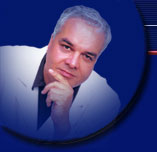 The trial of alternative medicine practitioner Dr. Matthias Rath started last week in Hamburg. Dr. Rath advocates a vitamin treatment to cure cancer. In this case a 9-year-old boy with bone cancer died after he [Dr. Rath] convinced the boy’s parents to use a “miracle cure” rich in vitamins and to reject conventional medical treatments.
The trial of alternative medicine practitioner Dr. Matthias Rath started last week in Hamburg. Dr. Rath advocates a vitamin treatment to cure cancer. In this case a 9-year-old boy with bone cancer died after he [Dr. Rath] convinced the boy’s parents to use a “miracle cure” rich in vitamins and to reject conventional medical treatments.
The child’s mother, Anke Feld, tells a bizarre story of conspiracy among physicians, conventional medicine, and the pharmaceutical industry in which her son was a pawn. She believes her son “died as a result of the numerous clinical and medical errors and the negligence with which our son was treated in the different hospitals.”
Dr. Rath, whom Ms. Feld thanks for his support and guidance, is the founder of Cellular Medicine, which his website describes as a groundbreaking concept that identifies nutritional deficiencies at the cellular level as a root cause of many chronic diseases. A critical view of him is provided here.
7/28/06 15:32 JR
New sunscreen will be available this fall
The Food and Drug Administration approved Anthelios SX today. It is a moisturizer and sun blocker from L’Oreal.
Anthelios SX will contains avobenzone (blocks UVA) and octocrylenem (blocks UVB). Both ingredients are already found in sunscreens sold in the U.S. What’s new about Anthelios SX is that it will also contain ecamsule, which blocks short UVA and has not previously been sold in the U.S. Ecamsule has been marketed in Europe and Canada as Mexoryl SX since 1993.
UVA rays account for approximately 95% of all ultraviolet energy. They can cause permanent damage to DNA. UVA passes through glass, and the effects do not show right away. By comparison, UVB rays cause sunburn but do not penetrate as deeply as UVA rays.
The product will be available in the fall, just in time for ski season.
7/24/06 15:03 JR
Follow-up: Becoming trans fat free
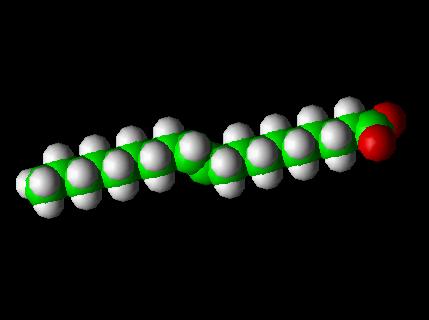 Earlier this month this site discussed trans fats, including the initiative to make Chicago the first major city in the country to go trans fat free. Now, The New York Times has published an article on alderman Edward Burke and his proposal.
Earlier this month this site discussed trans fats, including the initiative to make Chicago the first major city in the country to go trans fat free. Now, The New York Times has published an article on alderman Edward Burke and his proposal.
Chicago’s representatives are a “progressive” lot. They forbid restaurants from selling foie gras and may force cabbies to dress better. However, one major obstacle stands in the way. Mayor Richard Daley thinks it’s one rule too many. With such formidable opposition, Mr. Burke’s proposal may languish.
If you have an opinion contact the mayor at his office via facsimile: 312-744-8045. Or, send an email.
7/23/06 09:35 JR
Biofeedback and functional constipation
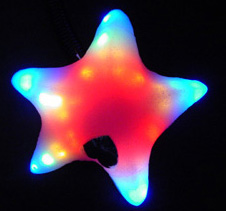 Medscape has a summary of presentations from this year’s Digestive Disease Week (DDW) meeting, which is the world’s largest gathering of physicians and researchers who specialize in diseases of the intestines and liver.
Medscape has a summary of presentations from this year’s Digestive Disease Week (DDW) meeting, which is the world’s largest gathering of physicians and researchers who specialize in diseases of the intestines and liver.
One presentation looked at the role of biofeedback in patients with functional constipation. Among 60 patients studied, the group treated with biofeedback had a significant reduction in straining, feelings of incomplete evacuation, bloating, and laxative use.
Functional constipation, also known as chronic idiopathic constipation, is a rare condition that occurs most often in women and may be related to problems in hormone function or with nerves and muscles in the colon, rectum, or anus.
7/20/06 10:29 JR
Not your typical vacation
Do you have vacation time coming in 2006? Herbalgram.org has listed the 2006 events calendar. Rather than the same Caribbean vacation or week at the Jersey shore, consider linking your vacation to a CAM meeting.
Here’s one that makes my tastebuds tingle.
July 30-Aug 5: Wild Foods Mountain Retreat. A week-long program in Virginia’s Blue Ridge Mountains. Forage for wild edible and medicinal plants, and prepare tasty and nutritional meals.
Hmm, Hmm, Hmm.
Other must attend meetings.
October 16-17: First International Symposium on Pomegranate and Minor Mediterranean Fruits. Adana, Turkey.
or
October 28-30: The 2nd Internatiomal Symposium on Saffron Biology and Technology (ISSBT). Mashhad, Iran.
Do you think CAM is becoming too specialized?
Want to see more? Go to the Herbalgram.org website.
7/18/06 13:20 JR
You can use it, but I own it.
![]() ? Copyright ? 2006, The MedCom Resource, Inc. www.MedComRes.com
? Copyright ? 2006, The MedCom Resource, Inc. www.MedComRes.com
Wyeth questions the role of pharmacists to compound HRT
 Â In April, Wyeth Labs renewed its request (submitted last October) for increased FDA regulation of compounding pharmacies that prepare hormone replacement therapy (HRT). Wyeth markets the HRT called Premarin and asserts that the HRT medicines prepared by compounding pharmacies can pose serious health risks.
 In April, Wyeth Labs renewed its request (submitted last October) for increased FDA regulation of compounding pharmacies that prepare hormone replacement therapy (HRT). Wyeth markets the HRT called Premarin and asserts that the HRT medicines prepared by compounding pharmacies can pose serious health risks.
Here is some historical perspective. Prior to the 1950s, when commercially prepared drugs became widely available, compounding prescriptions to be taken by mouth or inserted rectally was the main function of community pharmacists. In fact, as late as the 1970s (at least in New Jersey), compounding was part of the licensing exam for pharmacists.
In the 1970s, with the advent of total parenteral nutrition, preparation (compounding) of injectables increased by hospital pharmacists. In the 1980s there was a resurgence of compounding in community pharmacies.
In an excellent review, Dr. David Newton states, “Since the early 1990s, most national pharmacy practitioner organizations have asserted compounding is an intrinsic professional practice to be regulated by state boards of pharmacy.” The FDA usually defers to state boards to oversee this practice. Yet, state boards lack inspectors to enforce compounding practice standards, and most boards of pharmacy do not examine the compounding proficiency of their licensure candidates.
The implications of Wyeth’s anticompetitive petition according to the International Association of Compounding Pharmacists, is the “end to the option of prescribing bio-identical hormone replacement therapy for those patients that need it.”
The FDA is reviewing Wyeth’s request.
7/16/06 10:40 JR
Consumer alert: Conting Qianweisu Slimming Herbs Capsule
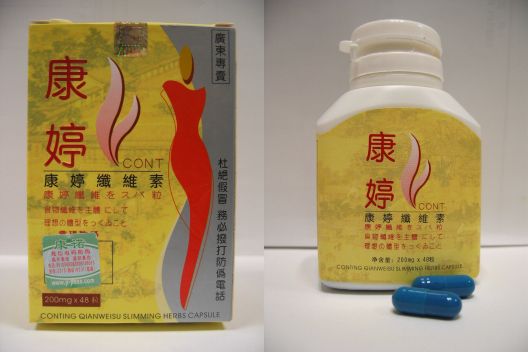 Just got back from vacation? Did you enjoy your trip to Hong Kong? What’s that you say, you found a great diet pill there that you put in your suitcase and took home?
Just got back from vacation? Did you enjoy your trip to Hong Kong? What’s that you say, you found a great diet pill there that you put in your suitcase and took home?
It’s called what? “Conting Qianweisu Slimming Herbs Capsule”?
Hmm, catchy name. Caution!
Continue reading Consumer alert: Conting Qianweisu Slimming Herbs Capsule
Lack of a direct association between marijuana and lung cancer
A newly published review in the Archives of Internal Medicine confirms what has been known since 1988. Epidemiological and clinical data do not show a direct cause and effect relationship between marijuana smoking and the development of lung cancer.
Possible reasons that studies detect lung damage but not cancer in marijuana smokers include the young age of the smokers studied, the small number of people included in each study, and the lack of long-term monitoring.
What was found in marijuana smokers included the following:
- The lungs are exposed to tar (the solid residue of tobacco smoke containing byproducts of combustion)
- The macrophage cells in the alveoli (the oxygen exchange cells) that should protect against noxious substances do not work properly
- There is increased oxidative stress
- Cells in the bronchi (the air passages) show an increase in abnormal and precancerous findings
Since some bronchial cell changes appear to be precancerous, an increased risk of cancer among frequent marijuana smokers is possible.
7/15/06 14:20 JR
Cannabis club banned at Fisherman’s Warf
This site reported previously about the growing resistance to medical cannabis clubs in San Francisco. Apparently, it is having an effect.
Now, The New York Times reports, “Marijuana cannot be sold alongside the cracked crab and souvenirs of Fisherman?s Wharf, the San Francisco Planning Commission decided late Thursday.” One commissioner stated, “the neighborhood was adamantly opposed to the dispensary?.
The cracked crabs will appeal.
7/14/06 09:30 JR
When is a side effect not a side effect?
Cultures around the world differ in what is considered a side effect (SE) that is important enough to report to a doctor during treatment or by a researcher during a clinical trial. Here are first-hand examples of what I mean. At the end I’ll explain why these differences are important.
SEs in Germany: The diabetes drug Precose (acarbose) was first tested in Germany, then marketed in Japan, and finally tested and marketed in the U.S. My first experience was in writing articles about Precose for Japanese doctors.
The German data indicated that flatulence was a known SE, but not a major problem. Yet, when it was finally studied and marketed in the U.S., flatulence was so severe that it prevented most people from taking Precose for any length of time.
Frustrated, the U.S. product manager eventually asked his German counterparts why their data never identified flatulence as a serious problem. They answered that in German trials, reported SEs came from patients who completed a study. Well, of course these were patients not bothered by flatulence, and thus the reported incidence was low. It ignored all patients in Germany who discontinued treatment because of SEs, such as flatulence.
SEs in the U.S.: U.S. studies report SEs on all patients who participate even for one dose. Therefore, there is likely to be a discrepancy between what is reported in a U.S. vs. German clinical trial. (My experience goes back more than 10 years, and it is possible that German clinical trial design has changed since then.)
SEs in Japan: My experience in obtaining SE data from Japanese studies is based on experience with photodynamic therapy. At the request of the U.S. Food and Drug Administration, a company sent me to Japan to collect safety data on this treatment. To my surprise, Japanese research reports listed almost no SEs. I later learned that Japanese patients were loath to report SEs to their doctors, because it was a sign of disrespect. Well, semasen goziemas, as Steve Martin used to say.
In a previous post I reported the position of the World Health Organization regarding the safety of herbals. I hope this explains why we should be dubious of this position.
7/14/06 14:18 JR
Herbal medicines: Are they safe?
 Americans tend to assume that if a drug is sold either by prescription in a pharmacy or off the shelf in a convenience store that it is safe. Otherwise, the label would list the cautions that must be taken to use it safely.
Americans tend to assume that if a drug is sold either by prescription in a pharmacy or off the shelf in a convenience store that it is safe. Otherwise, the label would list the cautions that must be taken to use it safely.
In fact, this is not how the rest of the world views herbal medicines.
Court suppresses report on herbal treatment of tinnitus
In April 2006 Schwabe Pharma (Australia) launched a marketing campaign promoting Tebonin for “tinnitus and vertigo relief.” Tebonin is an extract of Ginkgo biloba leaves called EGB761.
Now, the British Medical Journal reports that a federal court in Australia has granted an injunction sought by the company to temporarily suppress a report by a consumer watchdog group called AusPharm Consumer Health Watch that is critical of this product.
The advertisement for Tebonin states that it has shown “through clinical research to be an effective treatment for a range of conditions relating to microcirculation including tinnitus, vertigo, peripheral circulation and cognitive function.”
It continues, “Tebonin optimizes the flow properties of the blood through capillaries increasing the amount of oxygen supplied to all organs, tissues and individual cells throughout the human body, effectively reducing the amount of free radicals within cells and enabling optimum cell function.”
A detailed review published in The Journal of the American Botanical Association makes no mention of EGB research on tinnitus or vertigo.
7/13/06 21:36 JR
Ketogenic diet for seizure control
Among patients with epilepsy who follow a ketogenic diet, complete seizure control after two years of treatment is achieved in 24%, while a 90% reduction in seizures is achieved in 52%. In other words, the reward for being able to tolerate this stringent, mathematically calculated diet that is high in fat and low in protein and carbohydrates is at least a 90% reduction in seizures in 3 out of 4 patients. These findings are part of a meta-analysis of 19 clinical trials of more than 1000 patients.
This is even more impressive when one considers that candidates for the diet are generally young children with medically intractable generalized seizures. It’s not easy. About 50% of patients drop out of the diet over time. The main reason given is that the diet was not effective. Other reasons include complaints that the diet is too restrictive, intolerability due to side effects, or just poor compliance that makes the effort not worthwhile.
The children and their parents and caregivers who stay with the effort deserve credit for their persistence and commitment, especially since the response is not immediate.
For more information on how the ketogenic diet works, go here. A good introduction is available here.
7/13/06 09:35 JR
Reversing neuropathic pain with diet and exercise
Exercise and diet can reduce neuropathic pain and help regenerate nerve fibers in overweight patients with impaired glucose tolerance (“Prediabetes”), according to research that was presented at the 2006 American Academy of Neurology 58th Annual Meeting.
Details of the study are reported here, and a review of the topic is presented here.
7/13/06 00:09 JR
Acupuncture: Does it matter where the needles go?
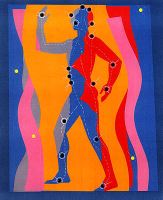 More than 1000 patients with chronic pain for at least 6 months due to osteoarthritis of the knee received up to 6 physiotherapy sessions and as-needed anti-inflammatory drugs. In addition, they were randomly assigned to receive 10 sessions of traditional Chinese acupuncture (TCA) or sham acupuncture from experienced acupuncture therapists, or 10 physician visits within 6 weeks.
More than 1000 patients with chronic pain for at least 6 months due to osteoarthritis of the knee received up to 6 physiotherapy sessions and as-needed anti-inflammatory drugs. In addition, they were randomly assigned to receive 10 sessions of traditional Chinese acupuncture (TCA) or sham acupuncture from experienced acupuncture therapists, or 10 physician visits within 6 weeks.
The inclusion of acupuncture led to greater improvement in Western Ontario and McMaster Universities Osteoarthritis Index (WOMAC) scores and physical functioning at 26 weeks.
But here is the point. (Sorry, I couldn’t help my self.) There was no significant difference in improvement between TCA and sham acupuncture. The researchers concluded that one explanation for the lack of any observed differences could be the physiologic effect of needling regardless of whether it is done according to TCA principles. Further analysis is provided here.
7/11/06 23:03 JR